IBM's Business Innovation: Strategies, Challenges, and Future Analysis
VerifiedAdded on 2021/05/31
|12
|2677
|119
Report
AI Summary
This report provides a comprehensive analysis of IBM's business innovation, examining its strategies, challenges, and future plans. It delves into IBM's approach to innovation, including its organizational structure, funding practices, and strategic alignment. The report explores key stakeholders, project selection methods, and the importance of a competitive environment. It details the development of infrastructure and innovation processes, including the role of research, external partnerships, and project management. Furthermore, it discusses the fostering of creativity, IBM's research initiatives, and the ecosystem that supports innovation. The report also highlights the importance of an innovation-fostering culture, including learning, training, and education, as well as the philosophy of innovation failure. It analyzes the success of innovation through investment tracking, evaluation, and the identification of breakthrough innovations. The report concludes with an examination of significant success factors, barriers to innovation, and future plans, along with key advice for fostering innovation. Finally, it answers questions about IBM's innovation and challenges, offering recommendations for future growth and development. This assignment is contributed by a student to be published on the website Desklib, a platform providing AI-based study tools.

Business Process Management
Paraphrase This Document
Need a fresh take? Get an instant paraphrase of this document with our AI Paraphraser
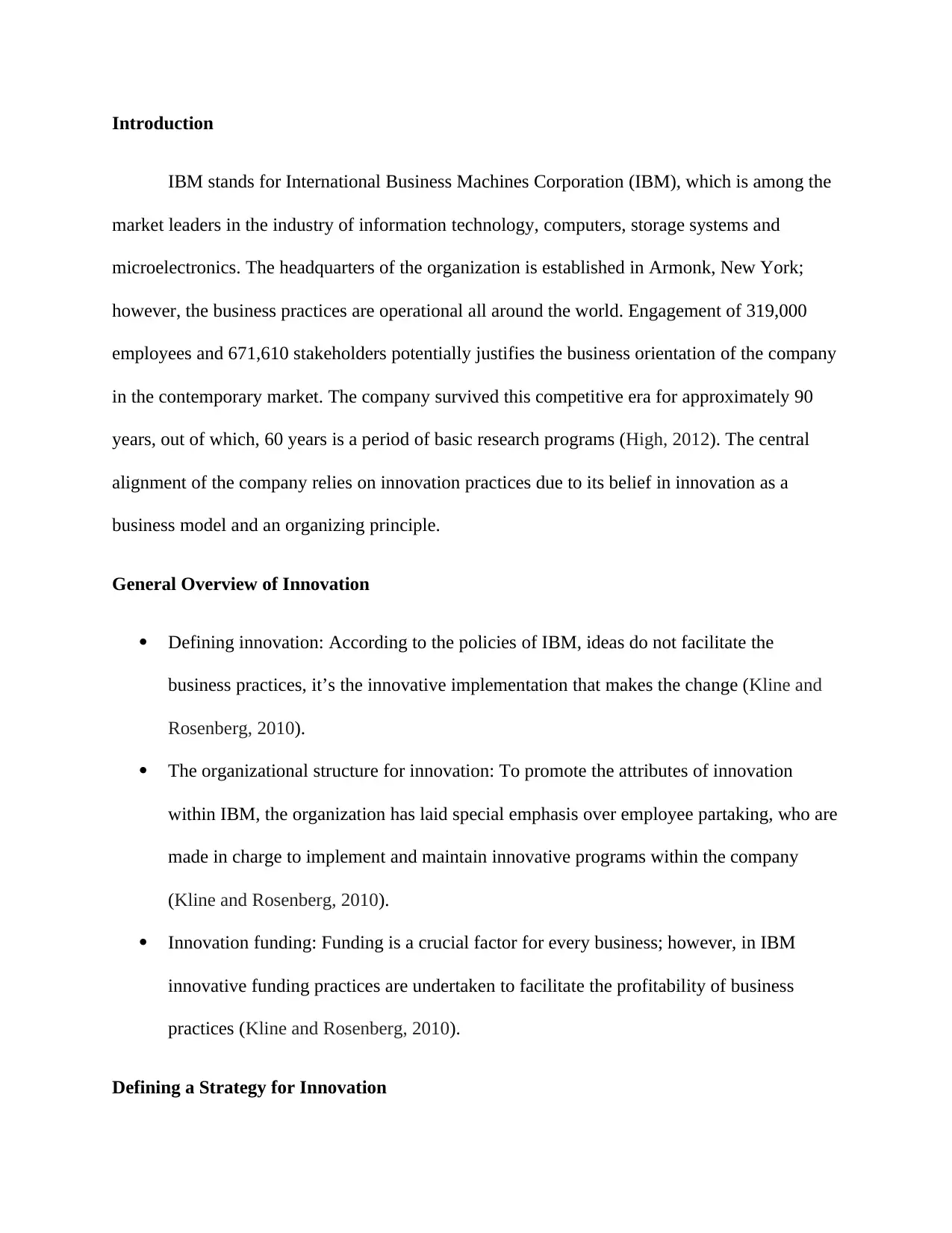
Introduction
IBM stands for International Business Machines Corporation (IBM), which is among the
market leaders in the industry of information technology, computers, storage systems and
microelectronics. The headquarters of the organization is established in Armonk, New York;
however, the business practices are operational all around the world. Engagement of 319,000
employees and 671,610 stakeholders potentially justifies the business orientation of the company
in the contemporary market. The company survived this competitive era for approximately 90
years, out of which, 60 years is a period of basic research programs (High, 2012). The central
alignment of the company relies on innovation practices due to its belief in innovation as a
business model and an organizing principle.
General Overview of Innovation
Defining innovation: According to the policies of IBM, ideas do not facilitate the
business practices, it’s the innovative implementation that makes the change (Kline and
Rosenberg, 2010).
The organizational structure for innovation: To promote the attributes of innovation
within IBM, the organization has laid special emphasis over employee partaking, who are
made in charge to implement and maintain innovative programs within the company
(Kline and Rosenberg, 2010).
Innovation funding: Funding is a crucial factor for every business; however, in IBM
innovative funding practices are undertaken to facilitate the profitability of business
practices (Kline and Rosenberg, 2010).
Defining a Strategy for Innovation
IBM stands for International Business Machines Corporation (IBM), which is among the
market leaders in the industry of information technology, computers, storage systems and
microelectronics. The headquarters of the organization is established in Armonk, New York;
however, the business practices are operational all around the world. Engagement of 319,000
employees and 671,610 stakeholders potentially justifies the business orientation of the company
in the contemporary market. The company survived this competitive era for approximately 90
years, out of which, 60 years is a period of basic research programs (High, 2012). The central
alignment of the company relies on innovation practices due to its belief in innovation as a
business model and an organizing principle.
General Overview of Innovation
Defining innovation: According to the policies of IBM, ideas do not facilitate the
business practices, it’s the innovative implementation that makes the change (Kline and
Rosenberg, 2010).
The organizational structure for innovation: To promote the attributes of innovation
within IBM, the organization has laid special emphasis over employee partaking, who are
made in charge to implement and maintain innovative programs within the company
(Kline and Rosenberg, 2010).
Innovation funding: Funding is a crucial factor for every business; however, in IBM
innovative funding practices are undertaken to facilitate the profitability of business
practices (Kline and Rosenberg, 2010).
Defining a Strategy for Innovation
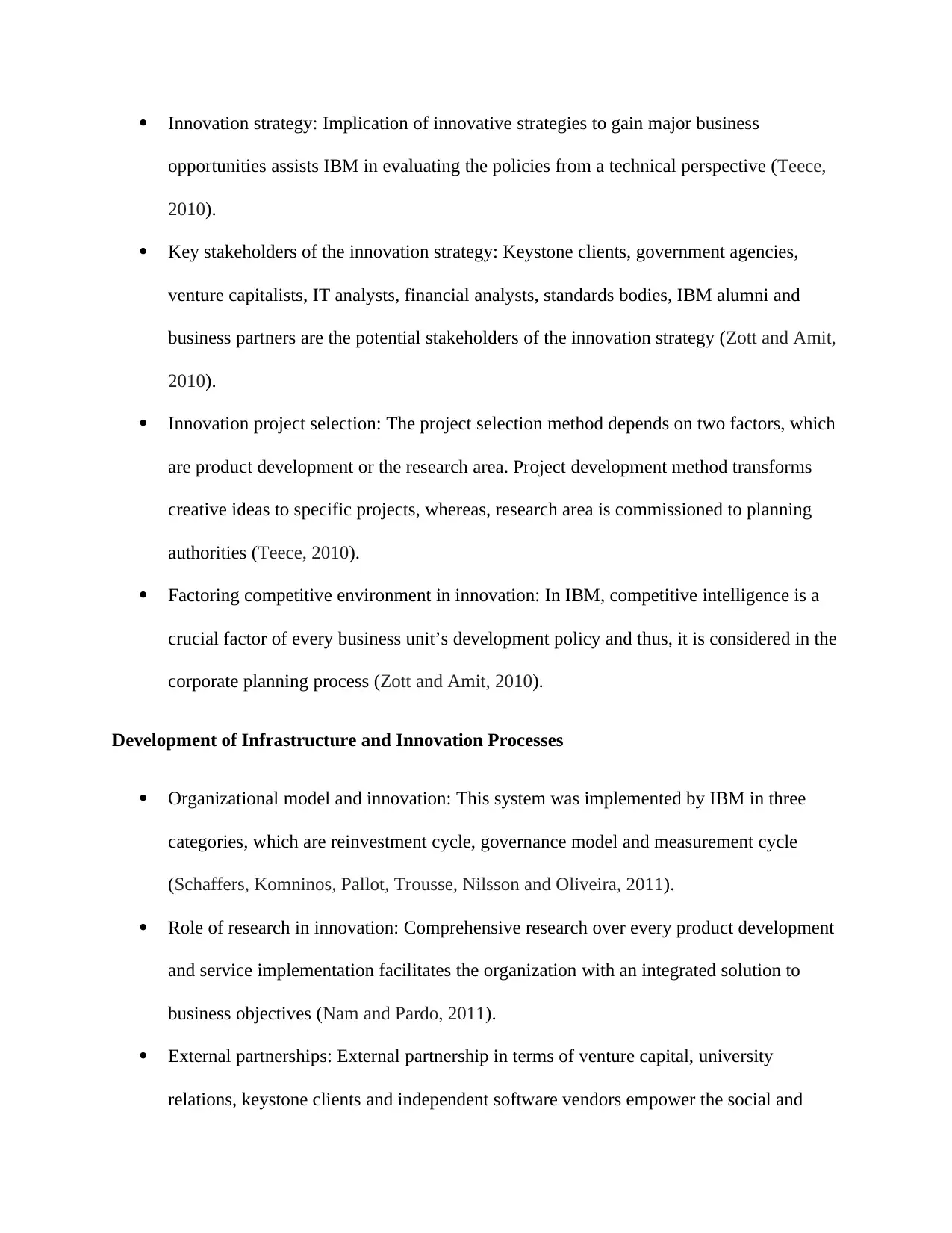
Innovation strategy: Implication of innovative strategies to gain major business
opportunities assists IBM in evaluating the policies from a technical perspective (Teece,
2010).
Key stakeholders of the innovation strategy: Keystone clients, government agencies,
venture capitalists, IT analysts, financial analysts, standards bodies, IBM alumni and
business partners are the potential stakeholders of the innovation strategy (Zott and Amit,
2010).
Innovation project selection: The project selection method depends on two factors, which
are product development or the research area. Project development method transforms
creative ideas to specific projects, whereas, research area is commissioned to planning
authorities (Teece, 2010).
Factoring competitive environment in innovation: In IBM, competitive intelligence is a
crucial factor of every business unit’s development policy and thus, it is considered in the
corporate planning process (Zott and Amit, 2010).
Development of Infrastructure and Innovation Processes
Organizational model and innovation: This system was implemented by IBM in three
categories, which are reinvestment cycle, governance model and measurement cycle
(Schaffers, Komninos, Pallot, Trousse, Nilsson and Oliveira, 2011).
Role of research in innovation: Comprehensive research over every product development
and service implementation facilitates the organization with an integrated solution to
business objectives (Nam and Pardo, 2011).
External partnerships: External partnership in terms of venture capital, university
relations, keystone clients and independent software vendors empower the social and
opportunities assists IBM in evaluating the policies from a technical perspective (Teece,
2010).
Key stakeholders of the innovation strategy: Keystone clients, government agencies,
venture capitalists, IT analysts, financial analysts, standards bodies, IBM alumni and
business partners are the potential stakeholders of the innovation strategy (Zott and Amit,
2010).
Innovation project selection: The project selection method depends on two factors, which
are product development or the research area. Project development method transforms
creative ideas to specific projects, whereas, research area is commissioned to planning
authorities (Teece, 2010).
Factoring competitive environment in innovation: In IBM, competitive intelligence is a
crucial factor of every business unit’s development policy and thus, it is considered in the
corporate planning process (Zott and Amit, 2010).
Development of Infrastructure and Innovation Processes
Organizational model and innovation: This system was implemented by IBM in three
categories, which are reinvestment cycle, governance model and measurement cycle
(Schaffers, Komninos, Pallot, Trousse, Nilsson and Oliveira, 2011).
Role of research in innovation: Comprehensive research over every product development
and service implementation facilitates the organization with an integrated solution to
business objectives (Nam and Pardo, 2011).
External partnerships: External partnership in terms of venture capital, university
relations, keystone clients and independent software vendors empower the social and
⊘ This is a preview!⊘
Do you want full access?
Subscribe today to unlock all pages.

Trusted by 1+ million students worldwide
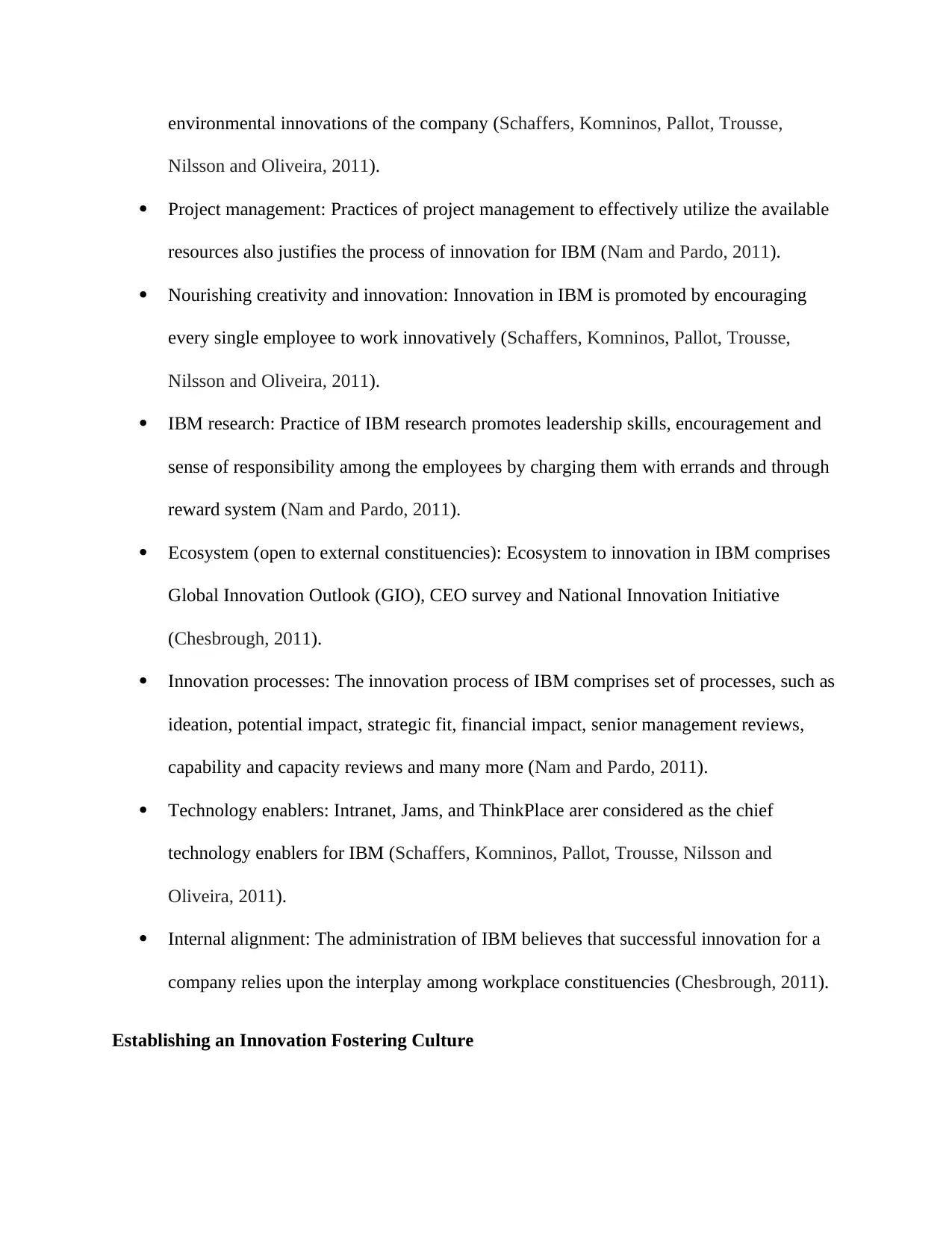
environmental innovations of the company (Schaffers, Komninos, Pallot, Trousse,
Nilsson and Oliveira, 2011).
Project management: Practices of project management to effectively utilize the available
resources also justifies the process of innovation for IBM (Nam and Pardo, 2011).
Nourishing creativity and innovation: Innovation in IBM is promoted by encouraging
every single employee to work innovatively (Schaffers, Komninos, Pallot, Trousse,
Nilsson and Oliveira, 2011).
IBM research: Practice of IBM research promotes leadership skills, encouragement and
sense of responsibility among the employees by charging them with errands and through
reward system (Nam and Pardo, 2011).
Ecosystem (open to external constituencies): Ecosystem to innovation in IBM comprises
Global Innovation Outlook (GIO), CEO survey and National Innovation Initiative
(Chesbrough, 2011).
Innovation processes: The innovation process of IBM comprises set of processes, such as
ideation, potential impact, strategic fit, financial impact, senior management reviews,
capability and capacity reviews and many more (Nam and Pardo, 2011).
Technology enablers: Intranet, Jams, and ThinkPlace arer considered as the chief
technology enablers for IBM (Schaffers, Komninos, Pallot, Trousse, Nilsson and
Oliveira, 2011).
Internal alignment: The administration of IBM believes that successful innovation for a
company relies upon the interplay among workplace constituencies (Chesbrough, 2011).
Establishing an Innovation Fostering Culture
Nilsson and Oliveira, 2011).
Project management: Practices of project management to effectively utilize the available
resources also justifies the process of innovation for IBM (Nam and Pardo, 2011).
Nourishing creativity and innovation: Innovation in IBM is promoted by encouraging
every single employee to work innovatively (Schaffers, Komninos, Pallot, Trousse,
Nilsson and Oliveira, 2011).
IBM research: Practice of IBM research promotes leadership skills, encouragement and
sense of responsibility among the employees by charging them with errands and through
reward system (Nam and Pardo, 2011).
Ecosystem (open to external constituencies): Ecosystem to innovation in IBM comprises
Global Innovation Outlook (GIO), CEO survey and National Innovation Initiative
(Chesbrough, 2011).
Innovation processes: The innovation process of IBM comprises set of processes, such as
ideation, potential impact, strategic fit, financial impact, senior management reviews,
capability and capacity reviews and many more (Nam and Pardo, 2011).
Technology enablers: Intranet, Jams, and ThinkPlace arer considered as the chief
technology enablers for IBM (Schaffers, Komninos, Pallot, Trousse, Nilsson and
Oliveira, 2011).
Internal alignment: The administration of IBM believes that successful innovation for a
company relies upon the interplay among workplace constituencies (Chesbrough, 2011).
Establishing an Innovation Fostering Culture
Paraphrase This Document
Need a fresh take? Get an instant paraphrase of this document with our AI Paraphraser
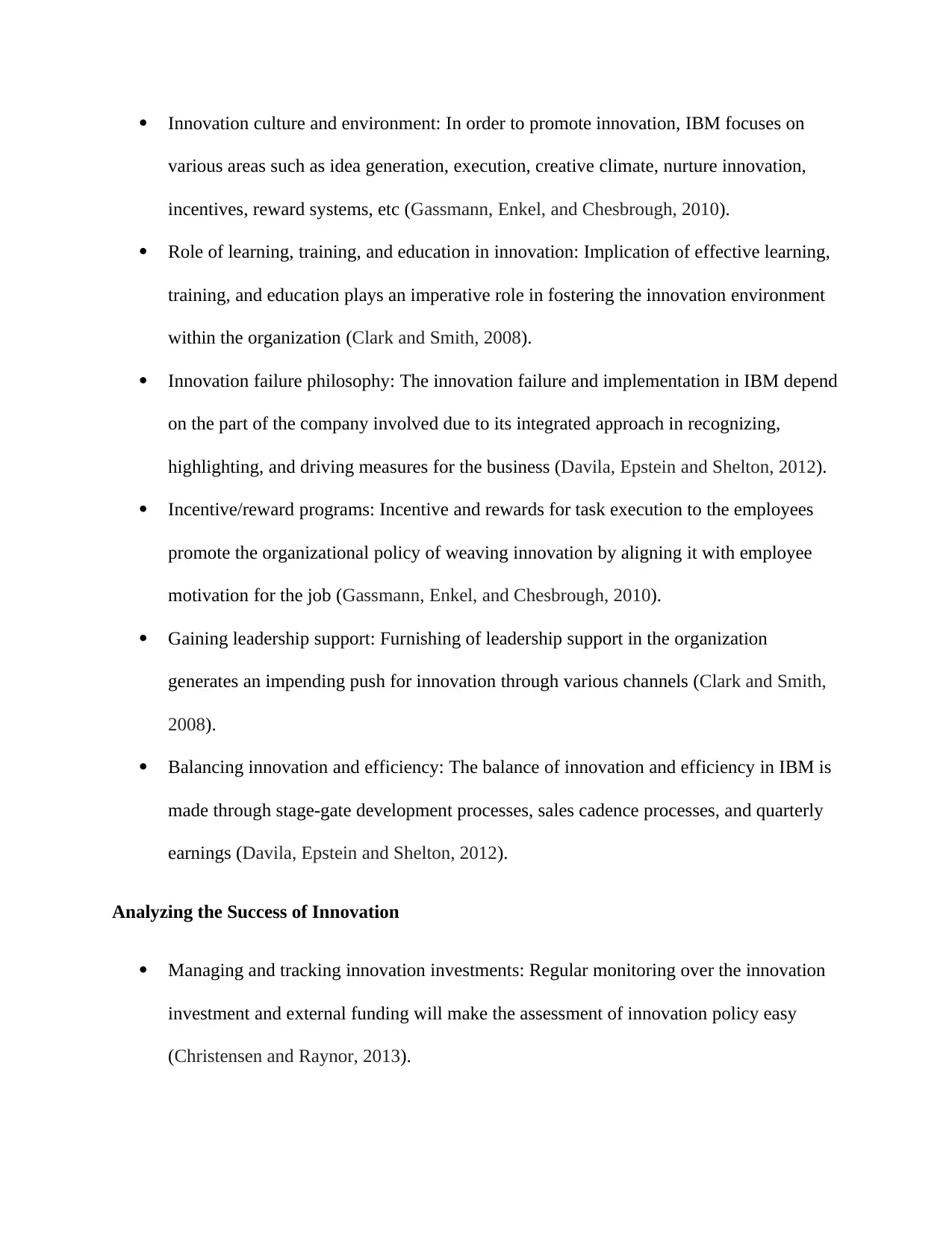
Innovation culture and environment: In order to promote innovation, IBM focuses on
various areas such as idea generation, execution, creative climate, nurture innovation,
incentives, reward systems, etc (Gassmann, Enkel, and Chesbrough, 2010).
Role of learning, training, and education in innovation: Implication of effective learning,
training, and education plays an imperative role in fostering the innovation environment
within the organization (Clark and Smith, 2008).
Innovation failure philosophy: The innovation failure and implementation in IBM depend
on the part of the company involved due to its integrated approach in recognizing,
highlighting, and driving measures for the business (Davila, Epstein and Shelton, 2012).
Incentive/reward programs: Incentive and rewards for task execution to the employees
promote the organizational policy of weaving innovation by aligning it with employee
motivation for the job (Gassmann, Enkel, and Chesbrough, 2010).
Gaining leadership support: Furnishing of leadership support in the organization
generates an impending push for innovation through various channels (Clark and Smith,
2008).
Balancing innovation and efficiency: The balance of innovation and efficiency in IBM is
made through stage-gate development processes, sales cadence processes, and quarterly
earnings (Davila, Epstein and Shelton, 2012).
Analyzing the Success of Innovation
Managing and tracking innovation investments: Regular monitoring over the innovation
investment and external funding will make the assessment of innovation policy easy
(Christensen and Raynor, 2013).
various areas such as idea generation, execution, creative climate, nurture innovation,
incentives, reward systems, etc (Gassmann, Enkel, and Chesbrough, 2010).
Role of learning, training, and education in innovation: Implication of effective learning,
training, and education plays an imperative role in fostering the innovation environment
within the organization (Clark and Smith, 2008).
Innovation failure philosophy: The innovation failure and implementation in IBM depend
on the part of the company involved due to its integrated approach in recognizing,
highlighting, and driving measures for the business (Davila, Epstein and Shelton, 2012).
Incentive/reward programs: Incentive and rewards for task execution to the employees
promote the organizational policy of weaving innovation by aligning it with employee
motivation for the job (Gassmann, Enkel, and Chesbrough, 2010).
Gaining leadership support: Furnishing of leadership support in the organization
generates an impending push for innovation through various channels (Clark and Smith,
2008).
Balancing innovation and efficiency: The balance of innovation and efficiency in IBM is
made through stage-gate development processes, sales cadence processes, and quarterly
earnings (Davila, Epstein and Shelton, 2012).
Analyzing the Success of Innovation
Managing and tracking innovation investments: Regular monitoring over the innovation
investment and external funding will make the assessment of innovation policy easy
(Christensen and Raynor, 2013).
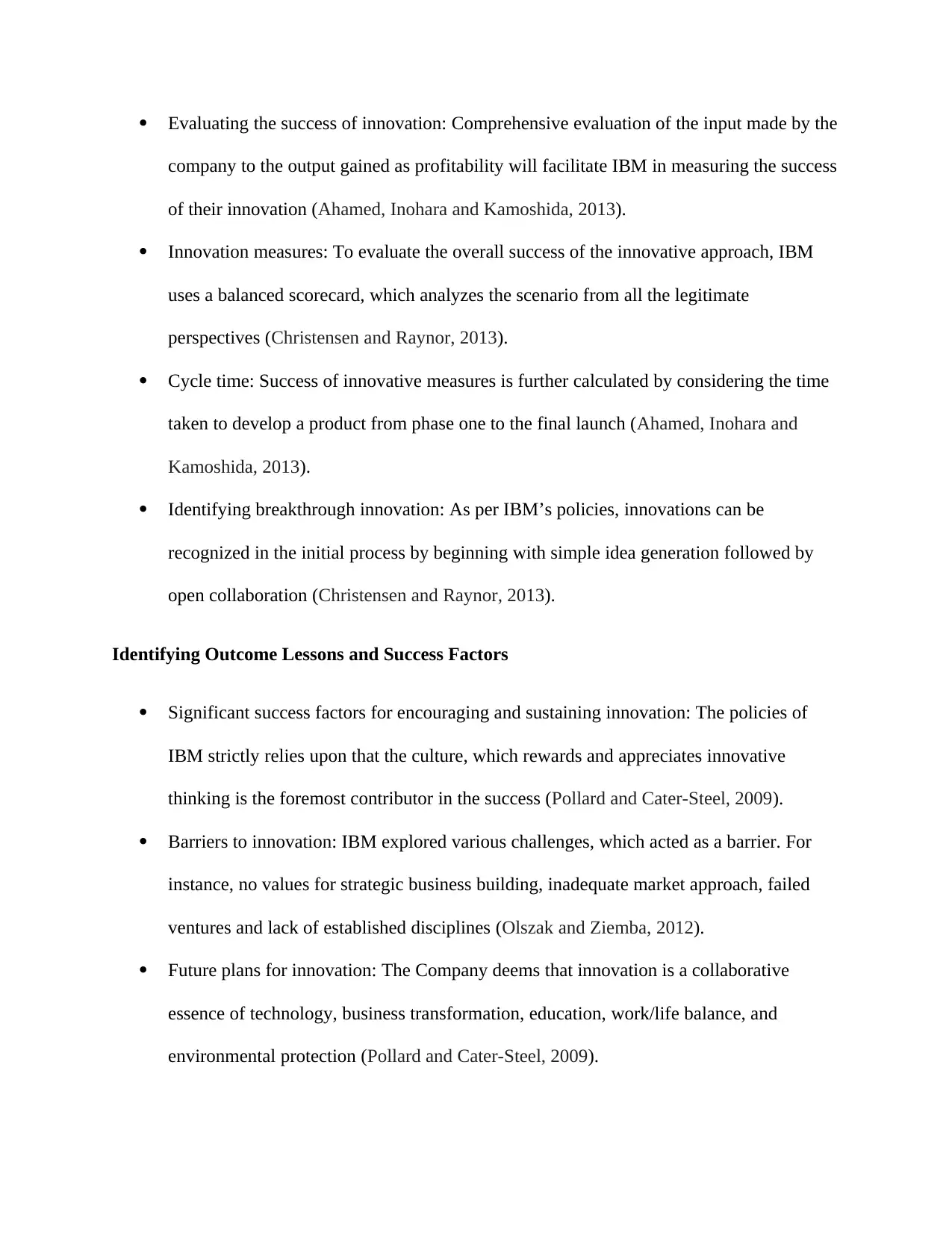
Evaluating the success of innovation: Comprehensive evaluation of the input made by the
company to the output gained as profitability will facilitate IBM in measuring the success
of their innovation (Ahamed, Inohara and Kamoshida, 2013).
Innovation measures: To evaluate the overall success of the innovative approach, IBM
uses a balanced scorecard, which analyzes the scenario from all the legitimate
perspectives (Christensen and Raynor, 2013).
Cycle time: Success of innovative measures is further calculated by considering the time
taken to develop a product from phase one to the final launch (Ahamed, Inohara and
Kamoshida, 2013).
Identifying breakthrough innovation: As per IBM’s policies, innovations can be
recognized in the initial process by beginning with simple idea generation followed by
open collaboration (Christensen and Raynor, 2013).
Identifying Outcome Lessons and Success Factors
Significant success factors for encouraging and sustaining innovation: The policies of
IBM strictly relies upon that the culture, which rewards and appreciates innovative
thinking is the foremost contributor in the success (Pollard and Cater-Steel, 2009).
Barriers to innovation: IBM explored various challenges, which acted as a barrier. For
instance, no values for strategic business building, inadequate market approach, failed
ventures and lack of established disciplines (Olszak and Ziemba, 2012).
Future plans for innovation: The Company deems that innovation is a collaborative
essence of technology, business transformation, education, work/life balance, and
environmental protection (Pollard and Cater-Steel, 2009).
company to the output gained as profitability will facilitate IBM in measuring the success
of their innovation (Ahamed, Inohara and Kamoshida, 2013).
Innovation measures: To evaluate the overall success of the innovative approach, IBM
uses a balanced scorecard, which analyzes the scenario from all the legitimate
perspectives (Christensen and Raynor, 2013).
Cycle time: Success of innovative measures is further calculated by considering the time
taken to develop a product from phase one to the final launch (Ahamed, Inohara and
Kamoshida, 2013).
Identifying breakthrough innovation: As per IBM’s policies, innovations can be
recognized in the initial process by beginning with simple idea generation followed by
open collaboration (Christensen and Raynor, 2013).
Identifying Outcome Lessons and Success Factors
Significant success factors for encouraging and sustaining innovation: The policies of
IBM strictly relies upon that the culture, which rewards and appreciates innovative
thinking is the foremost contributor in the success (Pollard and Cater-Steel, 2009).
Barriers to innovation: IBM explored various challenges, which acted as a barrier. For
instance, no values for strategic business building, inadequate market approach, failed
ventures and lack of established disciplines (Olszak and Ziemba, 2012).
Future plans for innovation: The Company deems that innovation is a collaborative
essence of technology, business transformation, education, work/life balance, and
environmental protection (Pollard and Cater-Steel, 2009).
⊘ This is a preview!⊘
Do you want full access?
Subscribe today to unlock all pages.

Trusted by 1+ million students worldwide
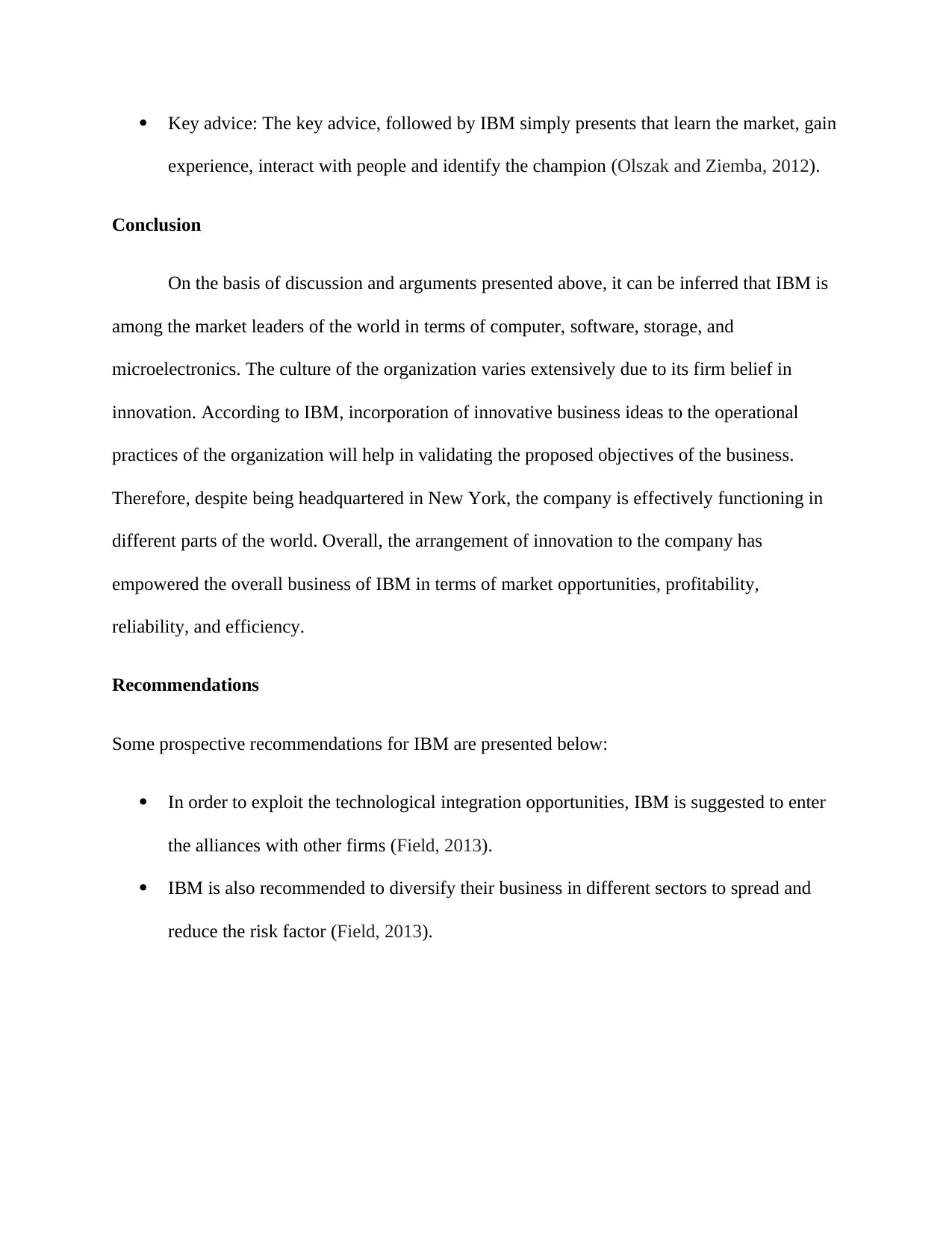
Key advice: The key advice, followed by IBM simply presents that learn the market, gain
experience, interact with people and identify the champion (Olszak and Ziemba, 2012).
Conclusion
On the basis of discussion and arguments presented above, it can be inferred that IBM is
among the market leaders of the world in terms of computer, software, storage, and
microelectronics. The culture of the organization varies extensively due to its firm belief in
innovation. According to IBM, incorporation of innovative business ideas to the operational
practices of the organization will help in validating the proposed objectives of the business.
Therefore, despite being headquartered in New York, the company is effectively functioning in
different parts of the world. Overall, the arrangement of innovation to the company has
empowered the overall business of IBM in terms of market opportunities, profitability,
reliability, and efficiency.
Recommendations
Some prospective recommendations for IBM are presented below:
In order to exploit the technological integration opportunities, IBM is suggested to enter
the alliances with other firms (Field, 2013).
IBM is also recommended to diversify their business in different sectors to spread and
reduce the risk factor (Field, 2013).
experience, interact with people and identify the champion (Olszak and Ziemba, 2012).
Conclusion
On the basis of discussion and arguments presented above, it can be inferred that IBM is
among the market leaders of the world in terms of computer, software, storage, and
microelectronics. The culture of the organization varies extensively due to its firm belief in
innovation. According to IBM, incorporation of innovative business ideas to the operational
practices of the organization will help in validating the proposed objectives of the business.
Therefore, despite being headquartered in New York, the company is effectively functioning in
different parts of the world. Overall, the arrangement of innovation to the company has
empowered the overall business of IBM in terms of market opportunities, profitability,
reliability, and efficiency.
Recommendations
Some prospective recommendations for IBM are presented below:
In order to exploit the technological integration opportunities, IBM is suggested to enter
the alliances with other firms (Field, 2013).
IBM is also recommended to diversify their business in different sectors to spread and
reduce the risk factor (Field, 2013).
Paraphrase This Document
Need a fresh take? Get an instant paraphrase of this document with our AI Paraphraser
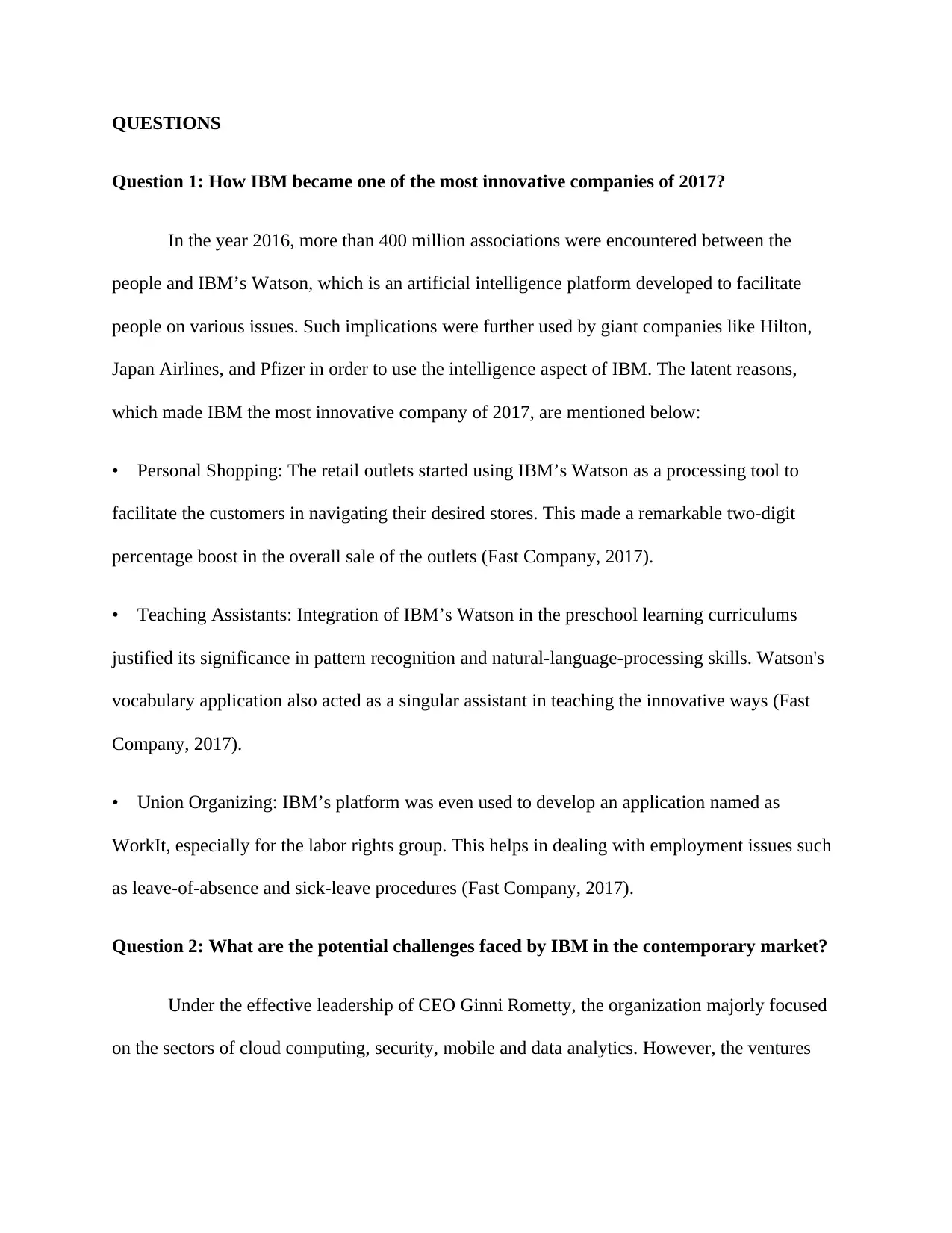
QUESTIONS
Question 1: How IBM became one of the most innovative companies of 2017?
In the year 2016, more than 400 million associations were encountered between the
people and IBM’s Watson, which is an artificial intelligence platform developed to facilitate
people on various issues. Such implications were further used by giant companies like Hilton,
Japan Airlines, and Pfizer in order to use the intelligence aspect of IBM. The latent reasons,
which made IBM the most innovative company of 2017, are mentioned below:
• Personal Shopping: The retail outlets started using IBM’s Watson as a processing tool to
facilitate the customers in navigating their desired stores. This made a remarkable two-digit
percentage boost in the overall sale of the outlets (Fast Company, 2017).
• Teaching Assistants: Integration of IBM’s Watson in the preschool learning curriculums
justified its significance in pattern recognition and natural-language-processing skills. Watson's
vocabulary application also acted as a singular assistant in teaching the innovative ways (Fast
Company, 2017).
• Union Organizing: IBM’s platform was even used to develop an application named as
WorkIt, especially for the labor rights group. This helps in dealing with employment issues such
as leave-of-absence and sick-leave procedures (Fast Company, 2017).
Question 2: What are the potential challenges faced by IBM in the contemporary market?
Under the effective leadership of CEO Ginni Rometty, the organization majorly focused
on the sectors of cloud computing, security, mobile and data analytics. However, the ventures
Question 1: How IBM became one of the most innovative companies of 2017?
In the year 2016, more than 400 million associations were encountered between the
people and IBM’s Watson, which is an artificial intelligence platform developed to facilitate
people on various issues. Such implications were further used by giant companies like Hilton,
Japan Airlines, and Pfizer in order to use the intelligence aspect of IBM. The latent reasons,
which made IBM the most innovative company of 2017, are mentioned below:
• Personal Shopping: The retail outlets started using IBM’s Watson as a processing tool to
facilitate the customers in navigating their desired stores. This made a remarkable two-digit
percentage boost in the overall sale of the outlets (Fast Company, 2017).
• Teaching Assistants: Integration of IBM’s Watson in the preschool learning curriculums
justified its significance in pattern recognition and natural-language-processing skills. Watson's
vocabulary application also acted as a singular assistant in teaching the innovative ways (Fast
Company, 2017).
• Union Organizing: IBM’s platform was even used to develop an application named as
WorkIt, especially for the labor rights group. This helps in dealing with employment issues such
as leave-of-absence and sick-leave procedures (Fast Company, 2017).
Question 2: What are the potential challenges faced by IBM in the contemporary market?
Under the effective leadership of CEO Ginni Rometty, the organization majorly focused
on the sectors of cloud computing, security, mobile and data analytics. However, the ventures
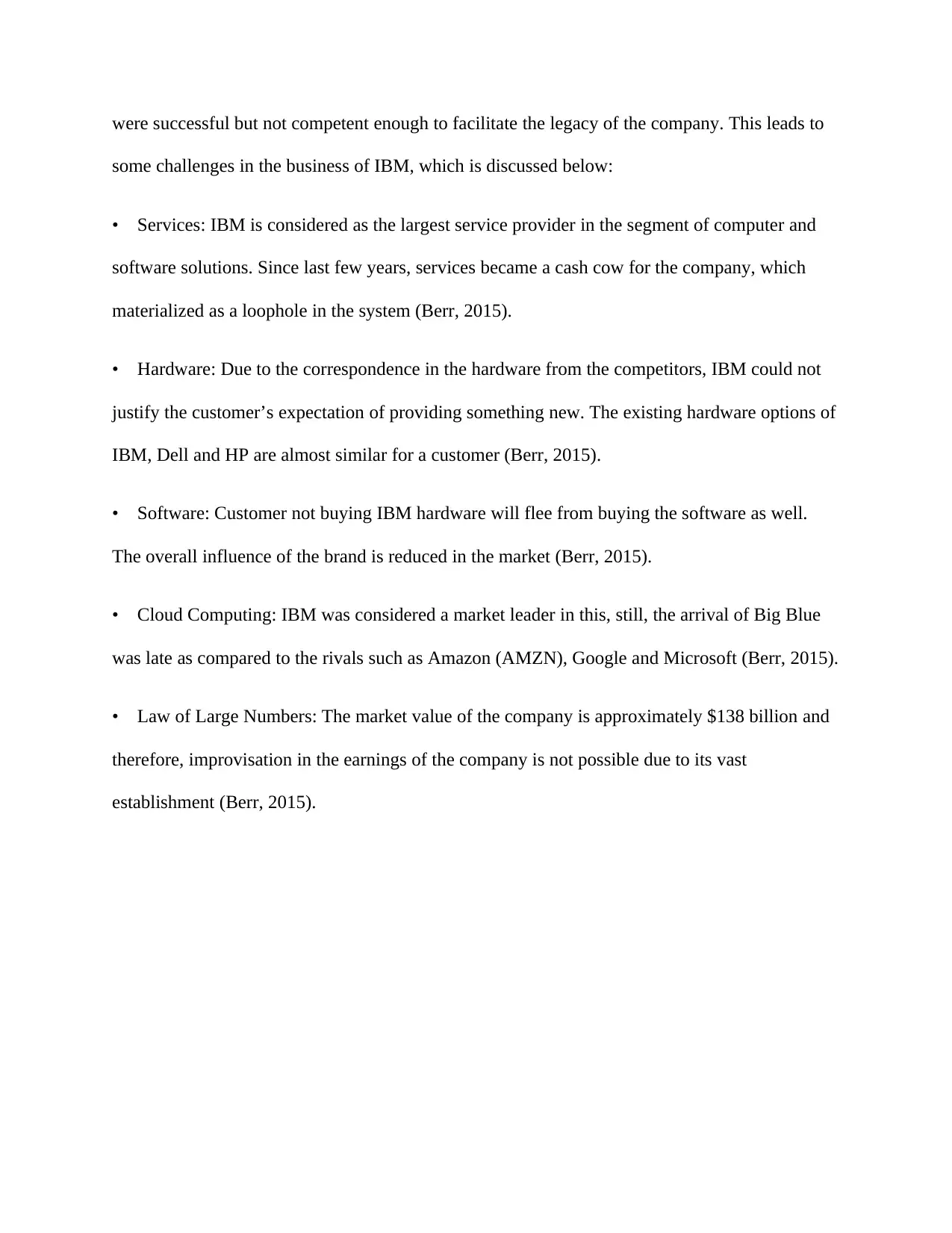
were successful but not competent enough to facilitate the legacy of the company. This leads to
some challenges in the business of IBM, which is discussed below:
• Services: IBM is considered as the largest service provider in the segment of computer and
software solutions. Since last few years, services became a cash cow for the company, which
materialized as a loophole in the system (Berr, 2015).
• Hardware: Due to the correspondence in the hardware from the competitors, IBM could not
justify the customer’s expectation of providing something new. The existing hardware options of
IBM, Dell and HP are almost similar for a customer (Berr, 2015).
• Software: Customer not buying IBM hardware will flee from buying the software as well.
The overall influence of the brand is reduced in the market (Berr, 2015).
• Cloud Computing: IBM was considered a market leader in this, still, the arrival of Big Blue
was late as compared to the rivals such as Amazon (AMZN), Google and Microsoft (Berr, 2015).
• Law of Large Numbers: The market value of the company is approximately $138 billion and
therefore, improvisation in the earnings of the company is not possible due to its vast
establishment (Berr, 2015).
some challenges in the business of IBM, which is discussed below:
• Services: IBM is considered as the largest service provider in the segment of computer and
software solutions. Since last few years, services became a cash cow for the company, which
materialized as a loophole in the system (Berr, 2015).
• Hardware: Due to the correspondence in the hardware from the competitors, IBM could not
justify the customer’s expectation of providing something new. The existing hardware options of
IBM, Dell and HP are almost similar for a customer (Berr, 2015).
• Software: Customer not buying IBM hardware will flee from buying the software as well.
The overall influence of the brand is reduced in the market (Berr, 2015).
• Cloud Computing: IBM was considered a market leader in this, still, the arrival of Big Blue
was late as compared to the rivals such as Amazon (AMZN), Google and Microsoft (Berr, 2015).
• Law of Large Numbers: The market value of the company is approximately $138 billion and
therefore, improvisation in the earnings of the company is not possible due to its vast
establishment (Berr, 2015).
⊘ This is a preview!⊘
Do you want full access?
Subscribe today to unlock all pages.

Trusted by 1+ million students worldwide
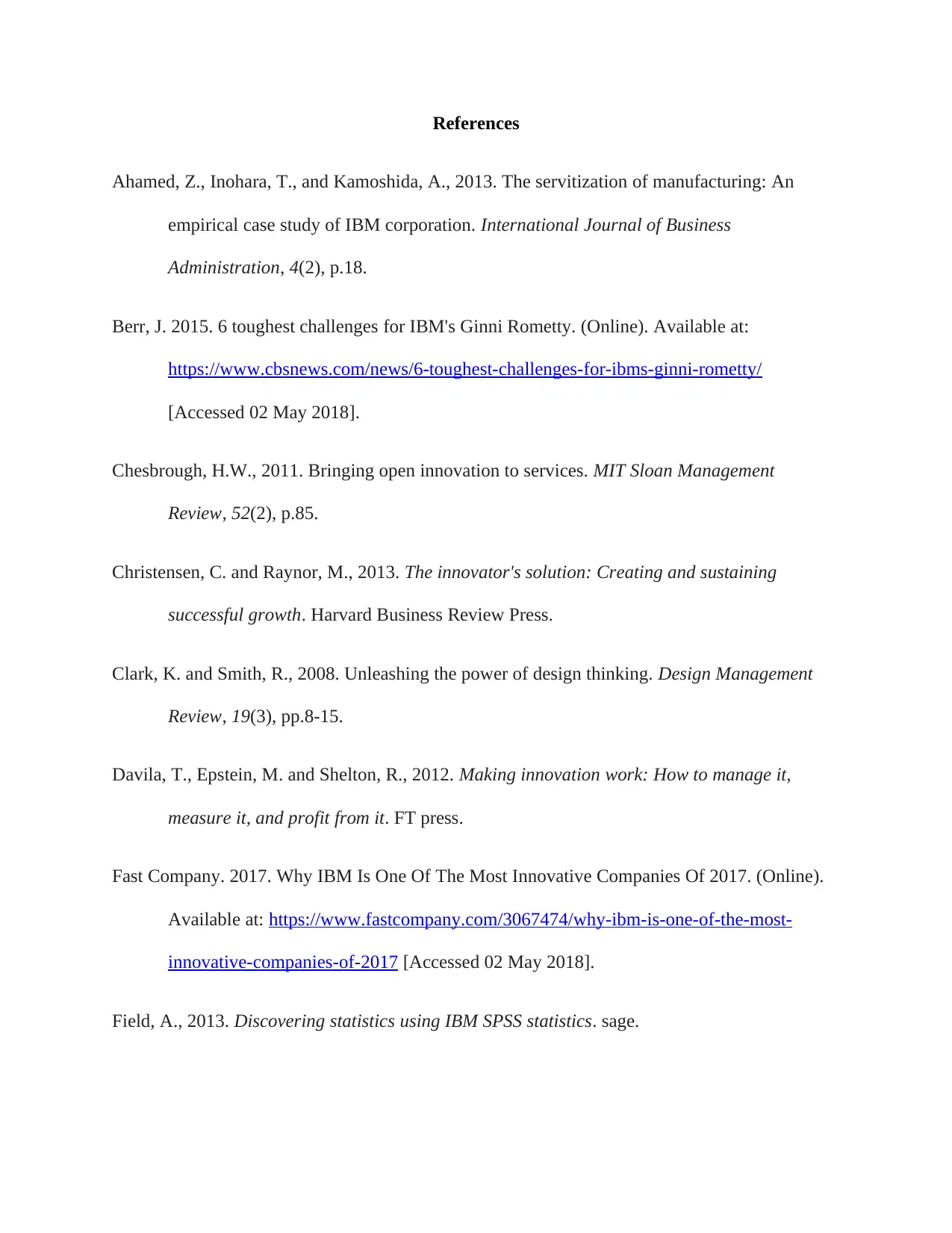
References
Ahamed, Z., Inohara, T., and Kamoshida, A., 2013. The servitization of manufacturing: An
empirical case study of IBM corporation. International Journal of Business
Administration, 4(2), p.18.
Berr, J. 2015. 6 toughest challenges for IBM's Ginni Rometty. (Online). Available at:
https://www.cbsnews.com/news/6-toughest-challenges-for-ibms-ginni-rometty/
[Accessed 02 May 2018].
Chesbrough, H.W., 2011. Bringing open innovation to services. MIT Sloan Management
Review, 52(2), p.85.
Christensen, C. and Raynor, M., 2013. The innovator's solution: Creating and sustaining
successful growth. Harvard Business Review Press.
Clark, K. and Smith, R., 2008. Unleashing the power of design thinking. Design Management
Review, 19(3), pp.8-15.
Davila, T., Epstein, M. and Shelton, R., 2012. Making innovation work: How to manage it,
measure it, and profit from it. FT press.
Fast Company. 2017. Why IBM Is One Of The Most Innovative Companies Of 2017. (Online).
Available at: https://www.fastcompany.com/3067474/why-ibm-is-one-of-the-most-
innovative-companies-of-2017 [Accessed 02 May 2018].
Field, A., 2013. Discovering statistics using IBM SPSS statistics. sage.
Ahamed, Z., Inohara, T., and Kamoshida, A., 2013. The servitization of manufacturing: An
empirical case study of IBM corporation. International Journal of Business
Administration, 4(2), p.18.
Berr, J. 2015. 6 toughest challenges for IBM's Ginni Rometty. (Online). Available at:
https://www.cbsnews.com/news/6-toughest-challenges-for-ibms-ginni-rometty/
[Accessed 02 May 2018].
Chesbrough, H.W., 2011. Bringing open innovation to services. MIT Sloan Management
Review, 52(2), p.85.
Christensen, C. and Raynor, M., 2013. The innovator's solution: Creating and sustaining
successful growth. Harvard Business Review Press.
Clark, K. and Smith, R., 2008. Unleashing the power of design thinking. Design Management
Review, 19(3), pp.8-15.
Davila, T., Epstein, M. and Shelton, R., 2012. Making innovation work: How to manage it,
measure it, and profit from it. FT press.
Fast Company. 2017. Why IBM Is One Of The Most Innovative Companies Of 2017. (Online).
Available at: https://www.fastcompany.com/3067474/why-ibm-is-one-of-the-most-
innovative-companies-of-2017 [Accessed 02 May 2018].
Field, A., 2013. Discovering statistics using IBM SPSS statistics. sage.
Paraphrase This Document
Need a fresh take? Get an instant paraphrase of this document with our AI Paraphraser
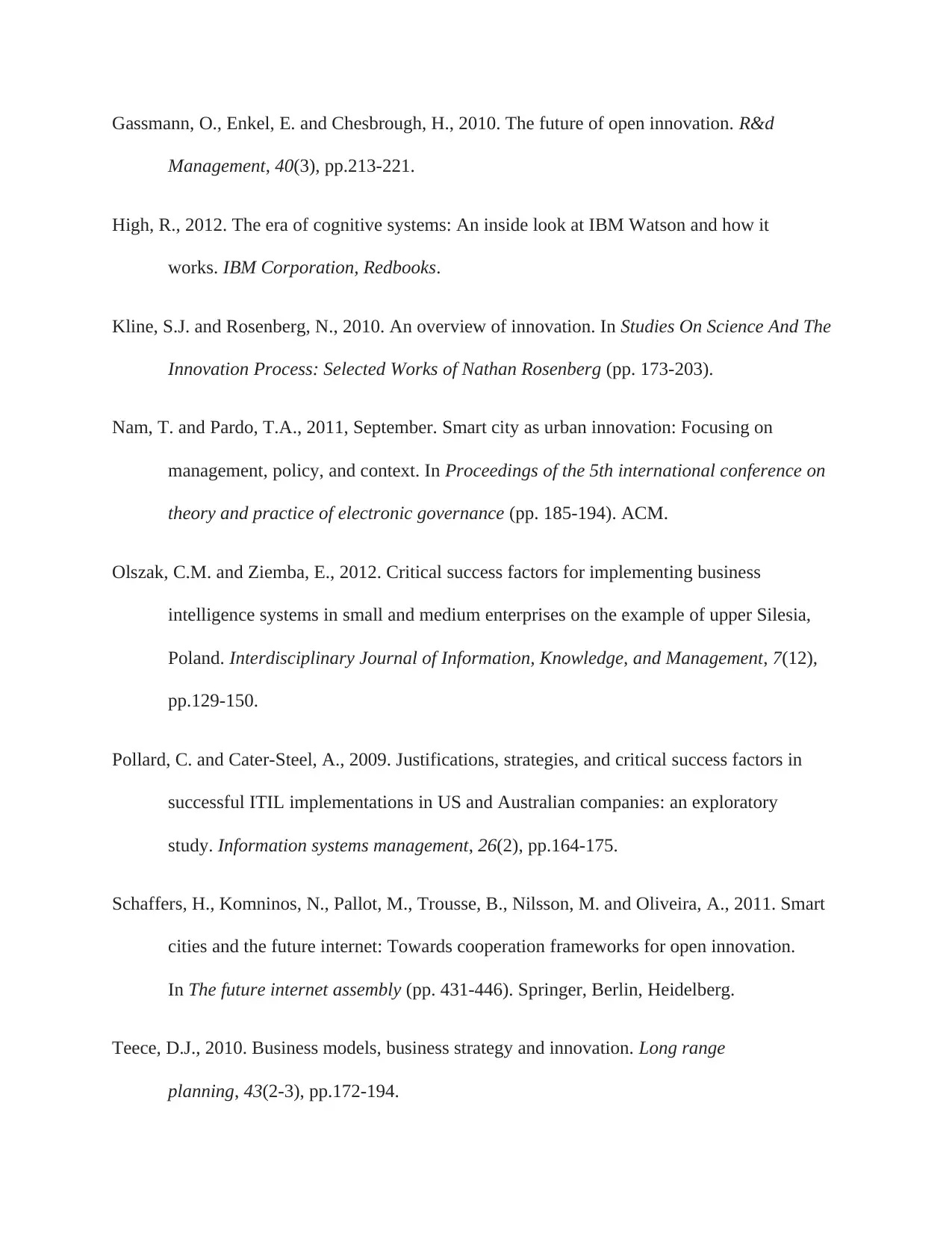
Gassmann, O., Enkel, E. and Chesbrough, H., 2010. The future of open innovation. R&d
Management, 40(3), pp.213-221.
High, R., 2012. The era of cognitive systems: An inside look at IBM Watson and how it
works. IBM Corporation, Redbooks.
Kline, S.J. and Rosenberg, N., 2010. An overview of innovation. In Studies On Science And The
Innovation Process: Selected Works of Nathan Rosenberg (pp. 173-203).
Nam, T. and Pardo, T.A., 2011, September. Smart city as urban innovation: Focusing on
management, policy, and context. In Proceedings of the 5th international conference on
theory and practice of electronic governance (pp. 185-194). ACM.
Olszak, C.M. and Ziemba, E., 2012. Critical success factors for implementing business
intelligence systems in small and medium enterprises on the example of upper Silesia,
Poland. Interdisciplinary Journal of Information, Knowledge, and Management, 7(12),
pp.129-150.
Pollard, C. and Cater-Steel, A., 2009. Justifications, strategies, and critical success factors in
successful ITIL implementations in US and Australian companies: an exploratory
study. Information systems management, 26(2), pp.164-175.
Schaffers, H., Komninos, N., Pallot, M., Trousse, B., Nilsson, M. and Oliveira, A., 2011. Smart
cities and the future internet: Towards cooperation frameworks for open innovation.
In The future internet assembly (pp. 431-446). Springer, Berlin, Heidelberg.
Teece, D.J., 2010. Business models, business strategy and innovation. Long range
planning, 43(2-3), pp.172-194.
Management, 40(3), pp.213-221.
High, R., 2012. The era of cognitive systems: An inside look at IBM Watson and how it
works. IBM Corporation, Redbooks.
Kline, S.J. and Rosenberg, N., 2010. An overview of innovation. In Studies On Science And The
Innovation Process: Selected Works of Nathan Rosenberg (pp. 173-203).
Nam, T. and Pardo, T.A., 2011, September. Smart city as urban innovation: Focusing on
management, policy, and context. In Proceedings of the 5th international conference on
theory and practice of electronic governance (pp. 185-194). ACM.
Olszak, C.M. and Ziemba, E., 2012. Critical success factors for implementing business
intelligence systems in small and medium enterprises on the example of upper Silesia,
Poland. Interdisciplinary Journal of Information, Knowledge, and Management, 7(12),
pp.129-150.
Pollard, C. and Cater-Steel, A., 2009. Justifications, strategies, and critical success factors in
successful ITIL implementations in US and Australian companies: an exploratory
study. Information systems management, 26(2), pp.164-175.
Schaffers, H., Komninos, N., Pallot, M., Trousse, B., Nilsson, M. and Oliveira, A., 2011. Smart
cities and the future internet: Towards cooperation frameworks for open innovation.
In The future internet assembly (pp. 431-446). Springer, Berlin, Heidelberg.
Teece, D.J., 2010. Business models, business strategy and innovation. Long range
planning, 43(2-3), pp.172-194.

Zott, C. and Amit, R., 2010. Business model design: an activity system perspective. Long range
planning, 43(2-3), pp.216-226.
planning, 43(2-3), pp.216-226.
⊘ This is a preview!⊘
Do you want full access?
Subscribe today to unlock all pages.

Trusted by 1+ million students worldwide
1 out of 12
Your All-in-One AI-Powered Toolkit for Academic Success.
+13062052269
info@desklib.com
Available 24*7 on WhatsApp / Email
![[object Object]](/_next/static/media/star-bottom.7253800d.svg)
Unlock your academic potential
Copyright © 2020–2025 A2Z Services. All Rights Reserved. Developed and managed by ZUCOL.